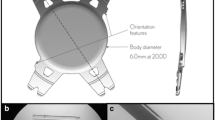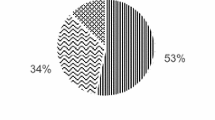Abstract
Purpose
To evaluate the temporary changes in visual outcomes and anterior segment parameters after cataract surgery plus low-add bifocal intraocular lens (IOL) implantation for primary angle closure disease (PACD).
Methods
This retrospective comparative case–control study included two groups: low-add-power segmented IOL and monofocal IOL. Postoperative examination involved evaluation of uncorrected distance visual acuity (UDVA), uncorrected near visual acuity (UNVA), uncorrected intermediate visual acuity (UIVA), and spherical equivalent (SE). Anterior segment examination was performed using anterior segment optical coherence tomography.
Results
This study included 19 eyes of 11 consecutive patients who underwent cataract surgery. The low-add group had better UDVA than the monofocal group at 3 months postoperatively, better UIVA at 1 month postoperatively, better UNVA at 1 week postoperatively. In the low-add group, SE increased at 1 and 3 months postoperatively compared with 1 week postoperatively. In the monofocal group, objective SE decreased at 1 and 3 months postoperatively compared with 1 week postoperatively. In the low-add group, the anterior chamber depth (ACD) became significantly deep gradually at 1 and 3 months compared with at 1 week postoperatively. In the monofocal group, the ACD became significantly shallow gradually at 1 and 3 months than at 1 week postoperatively.
Conclusion
The low-add-power segmented IOL achieved better far and intermediate distance visual acuity after cataract surgery in PACD patients than did the monofocal IOL. The ACD became deeper and SE showed a hyperopic shift with the low-add-power segmented IOL at 1 and 3 months after cataract surgery compared with at 1 week after cataract surgery.



Similar content being viewed by others
Data availability
Due to privacy and ethical concerns, neither the data nor the source of the data can be made available.
References
Prum BE Jr, Herndon LW Jr, Moroi SE, Mansberger SL, Stein JD, Lim MC, Rosenberg LF, Gedde SJ, Williams RD (2016) Primary angle closure preferred practice pattern((R)) guidelines. Ophthalmology 123:P1-p40. https://doi.org/10.1016/j.ophtha.2015.10.049
(2018) [The Japan Glaucoma Society Guidelines for Glaucoma (4rd Edition)]. 107:5–49
Azuara-Blanco A, Burr J, Ramsay C, Cooper D, Foster PJ, Friedman DS, Scotland G, Javanbakht M, Cochrane C, Norrie J (2016) Effectiveness of early lens extraction for the treatment of primary angle-closure glaucoma (EAGLE): a randomised controlled trial. Lancet 388:1389–1397. https://doi.org/10.1016/s0140-6736(16)30956-4
Vu AT, Bui VA, Vu HL, Quyet D, Thai TV, Nga VT, Dinh TC, Bac ND (2019) Evaluation of anterior chamber depth and anterior chamber angle changing after phacoemulsification in the primary angle close suspect eyes. Open Access Maced J Med Sci 7:4297–4300. https://doi.org/10.3889/oamjms.2019.378
Pedrotti E, Mastropasqua R, Bonetto J, Demasi C, Aiello F, Nucci C, Mariotti C, Marchini G (2018) Quality of vision, patient satisfaction and long-term visual function after bilateral implantation of a low addition multifocal intraocular lens. Int Ophthalmol 38:1709–1716. https://doi.org/10.1007/s10792-017-0652-x
Oshika T, Arai H, Fujita Y, Inamura M, Inoue Y, Noda T, Miyata K (2019) One-year clinical evaluation of rotationally asymmetric multifocal intraocular lens with +1.5 diopters near addition. Sci Rep 9:13117. https://doi.org/10.1038/s41598-019-49524-z
Kretz FT, Khoramnia R, Attia MS, Koss MJ, Linz K, Auffarth GU (2016) Clinical evaluation of functional vision of +1.5 Diopters near addition, aspheric, rotational asymmetric multifocal intraocular lens. Korean J Ophthalmol KJO 30:382–389. https://doi.org/10.3341/kjo.2016.30.5.382
Sawaguchi S, Sakai H, Iwase A, Yamamoto T, Abe H, Tomita G, Tomidokoro A, Araie M (2012) Prevalence of primary angle closure and primary angle-closure glaucoma in a southwestern rural population of Japan: the Kumejima Study. Ophthalmology 119:1134–1142. https://doi.org/10.1016/j.ophtha.2011.12.038
Vounotrypidis E, Diener R, Wertheimer C, Kreutzer T, Wolf A, Priglinger S, Mayer WJ (2017) Bifocal nondiffractive intraocular lens for enhanced depth of focus in correcting presbyopia: clinical evaluation. J Cataract Refract Surg 43:627–632. https://doi.org/10.1016/j.jcrs.2017.01.024
Venter JA, Pelouskova M, Collins BM, Schallhorn SC, Hannan SJ (2013) Visual outcomes and patient satisfaction in 9366 eyes using a refractive segmented multifocal intraocular lens. J Cataract Refract Surg 39:1477–1484. https://doi.org/10.1016/j.jcrs.2013.03.035
Behrouz MJ, Kheirkhah A, Hashemian H, Nazari R (2010) Anterior segment parameters: comparison of 1-piece and 3-piece acrylic foldable intraocular lenses. J Cataract Refract Surg 36:1650–1655. https://doi.org/10.1016/j.jcrs.2010.05.013
Nejima R, Miyai T, Kataoka Y, Miyata K, Honbou M, Tokunaga T, Kawana K, Kiuchi T, Oshika T (2006) Prospective intrapatient comparison of 6.0-millimeter optic single-piece and 3-piece hydrophobic acrylic foldable intraocular lenses. Ophthalmology 113:585–590. https://doi.org/10.1016/j.ophtha.2005.10.064
Hayashi K, Hayashi H (2005) Comparison of the stability of 1-piece and 3-piece acrylic intraocular lenses in the lens capsule. J Cataract Refract Surg 31:337–342. https://doi.org/10.1016/j.jcrs.2004.06.042
Choi M, Lazo MZ, Kang M, Lee J, Joo CK (2018) Effect of number and position of intraocular lens haptics on anterior capsule contraction: a randomized, prospective trial. BMC Ophthalmol 18:78. https://doi.org/10.1186/s12886-018-0742-1
Tsinopoulos IT, Tsaousis KT, Kymionis GD, Symeonidis C, Grentzelos MA, Diakonis VF, Adaloglou M, Dimitrakos SA (2010) Comparison of anterior capsule contraction between hydrophobic and hydrophilic intraocular lens models. Graefe’s Arch Clin Exp Ophthalmol Albrecht von Graefes Archiv fur klinische und experimentelle Ophthalmologie 248:1155–1158. https://doi.org/10.1007/s00417-010-1373-2
Dubbelman M, van der Heijde GL, Weeber HA (2001) The thickness of the aging human lens obtained from corrected Scheimpflug images. Optometry Vis Sci 78:411–416. https://doi.org/10.1097/00006324-200106000-00013
Fontana ST, Brubaker RF (1980) Volume and depth of the anterior chamber in the normal aging human eye. Arch. Ophthalmol. (Chicago, Ill: 1960) 98:1803–1808. https://doi.org/10.1001/archopht.1980.01020040655013
Funding
Not applicable.
Author information
Authors and Affiliations
Contributions
YC was involved in design and conduct of the study, collection, management and preparation; YC and YA performed analysis and interpretation of the data; YC, YA, HK reviewed and approved the manuscript. The authors would like to thank Enago for the English language review.
Corresponding author
Ethics declarations
Conflict of interest
The authors declare that they have no conflict of interest.
Animal research
Not applicable.
Ethics approval
This retrospective review of patient data was approved by the Human Studies Committee of University of the Ryukyus (No. 1267).
Additional information
Publisher's Note
Springer Nature remains neutral with regard to jurisdictional claims in published maps and institutional affiliations.
Rights and permissions
About this article
Cite this article
Chikaraishi, Y., Arakaki, Y. & Koizumi, H. Temporary changes of visual outcomes and anterior chamber parameters after phacoemulsification and low-add-power segmented intraocular lens implantation for primary angle closure disease. Int Ophthalmol 41, 2485–2494 (2021). https://doi.org/10.1007/s10792-021-01803-3
Received:
Accepted:
Published:
Issue Date:
DOI: https://doi.org/10.1007/s10792-021-01803-3




